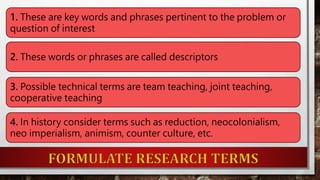RESEARCH PROBLEM AND REVIEW OF LITERATURE
- 2. DEFINE RESEARCH PROBLEM PRESENTATION OBJECTIVES
- 3. PRESENTATION OUTLINE DEFINITION ELEMENTS OF RESEARCH GUIDELINES IN THE SELECTION OF A RESEARCH PROBLEM SOURCES OF RESEARCH PROBLEM CRITERIA IN FORMULATING THE RESEARCH PROBLEM
- 4. •According to Kerlinger, ‘ . The answer to question will provide what is having sought in the research. •R.S. Woodworth defines problem as i.e. The solution can be found out only after an investigation.
- 5. an area of concern a troubling question a difficulty to be eliminated a condition to be improved
- 6. A Research Problem, or phenomenon as it might be called in many forms of qualitative research, is the topic you would like to address, investigate, or study, whether descriptively or experimentally.
- 7. 1. or aim of the problem which is to be investigated. 2. or theme which needs to be investigated. 3. The of a decision problem is always the future. 4. The in which the study is to be conducted. 5. from whom the data needs to be gathered.
- 8. 1. Select a research topic 2. Originality 3. Feasibility 4. Solvable/ Researchable 5. Current 6. Interesting
- 10. EXTERNAL CRITERIA NOVELTY – practical value of the problem AVAILABILITY OF THE SUBJECTS – capability and willingness of the respondents to participate SUPPORT OF THE ACADEMIC COMMUNITY – assistance given by the members of an institution AVAILABILITY AND ADEQUACY OF THE FACILITIES AND EQUIPMENTS – refers to whether or not needed for research are available ETHICAL CONSIDERATIONS – avoidance of unethical demands on the part of research participants.
- 11. INTERNAL CRITERIA EXPERIENCES, TRAINING AND QUALIFICATION OF THE RESEARCHER – refers to the researcher’s knowledge and expertise as results of experience and study. MOTIVATION, INTERESTS, AND INTELLECTUAL CURIOSITY OF THE RESEARCHER – refers to the essential attitudes of the researchers that brings enjoyment and satisfaction to him in doing the researcher. HAZARD, PENALTIES, AND HANDICAPS – refers to the researcher’s physical and intellectual capacity and moral judgement.
- 12. This is one of the most important parts of a research report. This focus of the study and all questions stated should be categorically answered. Basically, every research starts with a problem/s. At the start, the problem it may have chosen is very broad. In this case, it needs to be made specific. Or the major problem may be broken into smaller limited ones
- 14. DEFINE THE LOCATING AND REVIEWING THE LITERATURE PRESENTATION OBJECTIVES
- 16. LITERATURE REVIEW important that your literature review is focused. Therefore, you should choose a limited number of studies that are central to your topic rather than trying to collect a wide range of studies that might not be closely connected. a summary of studies related to a particular area. It identifies and summarizes all the relevant research conducted on a particular topic.
- 17. 1. It helps researchers have an area of similar and related studies. 2. It helps them weigh information from a literature review in the light of their own concerns and situation. 3. This is required in for master’s and doctorate students when they design a thesis or a dissertation.
- 18. 1. A literature review helps researchers learn what others have written about a topic. 2. It lets researchers see the results of other related studies. 3. A detailed literature review is often required in a masters or doctoral students when they design a thesis or dissertation.
- 19. Go to general questions Be specific: What strategies should be used so principals can be judged to be effective? Define the research problem as precisely as possible.
- 20. 1. These are key words and phrases pertinent to the problem or question of interest 2. These words or phrases are called descriptors 3. Possible technical terms are team teaching, joint teaching, cooperative teaching 4. In history consider terms such as reduction, neocolonialism, neo imperialism, animism, counter culture, etc.
- 21. • – these contain reports of research on a wide range of educational topics. In Education, try the Educational Research Journal, Educational Administration Quarterly, etc. • – made by local school districts and professional associations
- 22. • This makes the searches of the literature fairly inexpensive, provides printouts and enable researchers to search more than one descriptor at one time. • The steps in a traditional manual are similar to those in a computer search • Some of the information in the Web are classified into indexes • To obtain specific information search engines should be used























